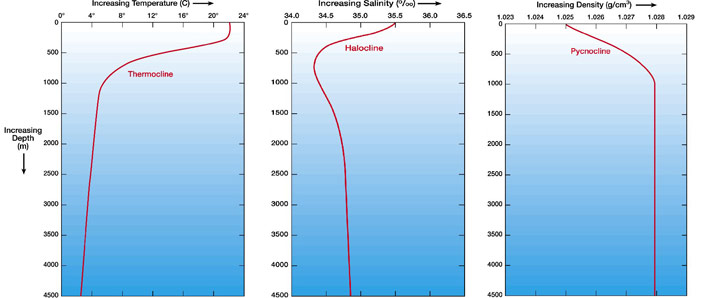The ocean is different from lakes and rivers for two primary reasons: the ocean is the biggest water body on the Earth and ocean water is salty. The salinity, or saltiness, of the ocean is a measure of the mass of dissolved salt in the ocean. The average salinity of the ocean is 35ppt (parts per thousand or ‰), which means that for every kilogram (1000 grams) of water, there are 35 grams of salt. The salt in the ocean is composed primarily (~85%) of sodium (Na+) and chloride (Cl-) ions. Salt in the ocean makes the ocean water more dense than fresh water. Salinity generally increases with water depth and saltier water is more dense. The temperature of the water also affects the density of water. In the ocean, temperature generally decreases with depth and colder water is more dense. Temperature and the salinity are the primary factors in determining the density of seawater. A vertical profile through the ocean will typically show an increasing density with depth.
Ocean water is mixed near the surface by wind, waves, evaporation, and currents. The near surface region where mixing occurs, called the mixed layer, usually has uniform water properties. The mixed layer is usually less than 150m deep. The depth of the warmer water in the mixed layer is an important factor in hurricane dynamics. The deeper the available warm water, the more energy for the hurricane. For that reason, researchers monitor the depth of the warm water in hurricane prone areas.
Below the mixed layer there is usually a region of rapidly changing temperature. This region is called the thermocline. The thermocline typically occurs at depths ranging from 100m to 200m in the open ocean, but can be found at much shallower depths in coastal regions. There can also be a seasonal thermocline at shallower depths than the deeper permanent thermocline. |



